If you’ve ever found yourself confronted with a dashboard light you didn’t understand, you’re not alone. There’s a certain sinking feeling that comes with the sight of an unintelligible wingding illuminating beyond the steering wheel that could fill a driver with dread. Is your car overheating? Is there something wrong with your headlights? Does the check engine light mean you need to visit a mechanic right away?
But there’s no reason to be anxious about dashboard lights. They are just the way your car communicates. Though many of the lights are merely notifications, warning lights in particular can deliver important information about vehicle maintenance. It is important to be able to understand the meaning of your dashboard lights and symbols and know what to do in response to them. Paying attention to these alerts, knowing what they mean and listening to them, can help you get more good years out of your car.
Different Types of Dashboard Lights
There are basically three grades of dash indicator lights: Green or Blue, Yellow or Orange, and Red.
- Green or blue dashboard lights are notification lights, telling you that a feature of your car is active. They do not signal a fault or problem. Rather, they are an indication that these parts of your car are functioning exactly how you want them to function.
- Yellow or orange dashboard lights are low-grade warning lights. There is a problem in your car that you should deal with in the very near future. Your car can usually still be driven a few miles, or the fix is one that can be easily taken care of, like closing your car door or pulling up to a gas station to fill your fuel tank.
- Red dashboard lights are serious warning lights. You should stop immediately, or risk damage to the car (or worse, yourself). If you are out driving when you see a red warning light, pull over and deal with the problem. If your car requires immediate attention from a professional, don’t drive it to the shop, contact AAA Roadside Assistance for a tow. The exception to the red warning rule is of course the hazard light symbol, which simply reminds the driver that they have engaged the hazard lights and is not an issue in itself.

Dashboard Lights Decoded
The infographic above highlights some of the most popular – and sometimes most confusing – dashboard lights and symbols. One of the difficulties that can come with deciphering dashboard light meanings is that the symbols vary between different makes and models of cars. Though the variation is often very slight, it is important to keep in mind that the symbols in your own car might look a little different than the ones seen here.
Many dashboard symbols use a sort of pictograph-style code to help the driver decipher it. The head lamp symbol, for example, is usually illustrated as an illuminated light bulb. While most of the images are pretty straightforward, like the low fuel symbol or the battery symbol, some can be confusing. The tire pressure symbol is ostensibly supposed to be a cross-section of a car tire with an exclamation point in the middle, and treads on the bottom; however, it looks more like an exclamation point in parenthesis, floating over a stout fence. The brake system dashboard light isn’t representative at all, deviating profoundly from the style of the other more illustrative symbols. The only way to instantly be able to recognize this symbol is simply by memorizing what it looks like. Some dash indicator lights blink when the driver’s attention is especially urgent, though this is not the case for all vehicles.
If you’re still unsure about what certain dashboard lights or symbols mean, you can always check your owner’s manual. If you have an iPhone running with iOS 17, you can also use the Visual Look Up feature, which has a “Look Up Auto Symbol” button.
If your dashboard light are telling you that your car needs maintenance, be sure to use a shop you can trust. Search for a AAA Approved Auto Repair Facility near you.
16 Thoughts on “What Are Your Dashboard Lights Trying To Tell You?”
Leave A Comment
Comments are subject to moderation and may or may not be published at the editor’s discretion. Only comments that are relevant to the article and add value to the Your AAA community will be considered. Comments may be edited for clarity and length.

















My 2015 ford focus has an error message of no key detected when I put my key in the ignition.
Any suggestions?
Sarah, that’s interesting because the Toyota Avalon either shows the symbol in yellow when the key fob is not present but it’s not displayed at all (it disappears) when the key fob is present. Thanks for the article.
Engine maintenance light? What does it mean
It looks like this is a version of the “check engine” light. This means that the engine must be checked by a professional as soon as possible. It could also be a version of the “maintenance required” light, which is a reminder to take your car in for maintenance at certain times. Consult your car owner manual for the exact meaning. Either way, I would make an appointment with a trusted mechanic.
– Sarah
Sarah, the symbol of the key with the exclamation point across it means that the key fob is not present and the car cannot be started without it. Your chart has it incorrectly do displayed as the opposite.
Actually, when the symbol is in green, it means that the key fob is present. The symbol to show that the key fob is missing is usually the same symbol, but in red. If it is in yellow, it usually means that the key fob has low battery or needs to be replaced. Thanks for reading!
– Sarah
Thanks for the information.
Very nice.
Traction Control
ABS
Thanks for the dashboard information on those idiot lights, I feel better now as well
Sarah! You are a wonderful writer. Your information was clear and easy to follow and actually made me laugh out loud with your delightful humor. Thank you ?
No, thank you! I’m glad you enjoyed the article.
– Sarah
Thank you
PLEASE CANCEL THIS DAILY MAGAZINE. TOO MUCH INFO.
Hi Mary,
Of course. I’ll forward your request and make sure you don’t receive the daily emails from now on.
-Dana